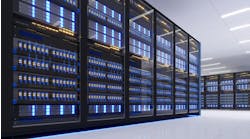Waste Heat Utilization is the Data Center Industry’s Next Step Toward Net-Zero Energy
Kris Holla, Group Vice President, Channel Sales, for Nortek Air Solutions, explains how waste heat utilization or heat recycling can work to further data centers’ quest for energy efficiency and change the industry’s reputation as a high energy consumer. However, not all data center cooling technology is suitable for waste heat recovery.
Kris Holla, Group Vice President, Channel Sales, for Nortek Air Solutions
Waste heat recovery from data centers is not only an emerging trend, it’s already being encouraged, and in some cases, mandated by governments. Unfortunately, not all current data centers employ cooling technologies that can best optimize this trend.
One of the biggest complaints lodged against data centers is that they’re energy hogs. However, now the trend points toward waste heat utilization. New concepts, such as energy reuse effectiveness (ERE), have given data centers an opportunity to be energy suppliers, not just users. Data centers have already made tremendous sustainability strides the last decades with significant reductions in both power usage effectiveness (PUE) and water usage effectiveness (WUE). Therefore waste heat utilization is just one more important step for data center operators to reach a future net-zero energy goal.
The Nordic countries are already implementing this new sustainability by rejecting data center hall server waste heat into district energy systems for reuse. Stockholm’s Data Parks, for example, hope to use waste heat from data centers to heat 10% of the city by 2035. This isn’t an anomaly. Other waste heat utilizations are occurring throughout Scandinavia, Germany and elsewhere.
The U.S. isn’t on par with Europe yet, however California has taken the first step and will be mandating waste heat recovery for data centers in its Title 24. Other states are expected to follow suit eventually. This is another illustration that the data center industry must improve sustainability for power and water, or governments will instead regulate it with mandates. This could limit the freedom the industry enjoys now concerning the choices of locations, cooling system methodology and a host of other decisions that should be made only by data center industry experts, not legislators.
Future data center projects can take a page from Amazon and Nordic countries, however waste heat recovery must be incorporated during the design phase of the cooling systems in the new construction or retrofits.
The waste heat utilization concept is also popping up randomly in the U.S. mostly modest efforts. Notre Dame University is using waste heat from a data center to heat a campus greenhouse. In another example, Syracuse University’s data center transfers excess cold and hot water for air conditioning and heating to a nearby building, respectively.
While these small scale examples are encouraging, the future in U.S. data center waste heat utilization might be most promising with district energy authorities. District energy is growing steadily across the U.S. and could easily help data centers reach larger scale waste heat utilization goals quickly and inexpensively, according to Rob Thornton, President and CEO of the International District Energy Association (IDEA). “In 2018, IDEA member organizations reported new commitments or renewal of 174 customer buildings in North America totaling 64,021,207-square feet of building space to district energy service during 2018 in comparison with 190 buildings and 50,028,785 square feet during 2017. The North America total of 64,021,207 square feet added in 2018 brings the running total for North America to 865,692,809 square feet, since voluntary reporting began in 1990. (See illustration A below)
District energy systems can be a recipient for data center waste heat. (Photo: International District Energy Association)
The IDEA also reports that North America has more than 940 district energy systems currently operating in cities, communities, campuses, military bases, airports and healthcare. While many of the district heating systems in U.S. cities and campuses use steam in distribution, system expansions and new-builds are often deploying medium or low temperature hot water systems for district heating. Thermal output or surplus heat from data centers can be utilized by a local district energy system as an integrated heating source, a pre-heat resource for a steam system or a primary resource for a new district energy cluster.
Amazon’s headquarters campus in downtown Seattle’s Denny Triangle is a good example of using data center waste heat utilization on a major scale. Simply, Amazon’s campus of buildings receives waste heat recovered from a neighboring building across a major street that houses 34 floors of data center halls. Return water from the building’s data center section runs under the street through an underground heat exchanger and heat recovery plant to supply radiant hot water heating for the Amazon campus’ three 37-story high-rise buildings, a 16-story mid-rise facility and a conference center. The data center area functions like a mini district energy utility for Amazon’s needs. The arrangement is also reciprocal. Post-heating water from the Amazon campus is returned for chilling and re-entry into the data center section to cool IT equipment and restart the cycle.
Future data center projects can take a page from Amazon and Nordic countries, however waste heat recovery must be incorporated during the design phase of the cooling systems in the new construction or retrofits. Not all data center cooling systems are conducive or efficient enough to extract the most waste energy with minimal thermal losses. Air cooling, for example, isn’t as efficient as liquid cooling for waste heat recovery. Liquids transfer energy 10 times more efficiently than air, therefore liquid cooling is the best methodology because its design inherently incorporates a chilled water loop for which to recover heat.
Indirect evaporative cooling technology that uses membrane heat exchangers (the tree trunk) has many branches for sustainability; heat recovery is one branch that should be designed into a project from its inception. (Photo: StatePoint—Nortek Air Solutions)
Direct evaporative cooling and other technologies often use air distribution into the data center that isn’t as efficient for waste heat recovery. Furthermore, existing data centers with air cooling are discovering difficulties tapping into the waste heat recovery trend, via direct or indirect evaporative cooling, because most of those systems require costly equipment add-ons, such as heat recovery coils and hydronic loops. Additionally, that mandatory heat recovery coil also requires a powered fan, which further degrades overall data center efficiency.
The most efficient data center cooling method for waste heat recovery is indirect evaporative cooling using semi-permeable exchanger (SPEX) technology called StatePoint. This method already has a built-in hydronic loop, that’s ready for heat transfer to a district energy system. However, there are additional benefits beyond waste heat recovery. Indirect evaporative cooling with SPEX use patented microporous membranes that help the system outperform other liquid cooling alternatives for ERE, PUE and WUE. This new liquid cooling methodology has been lab tested. It has been proven as one of the most sustainable data center cooling technologies available today, because it potentially reduces liquid cooling water and power consumption by up to 90 and 60%, respectively.
The semi-permeable exchanger (SPEX) uses microporous membranes for heat exchange that totally separate water from the air. (Illustration: StatePoint—Nortek Air Solutions)
What makes indirect evaporative cooling with SPEX technology ideal for waste heat recovery is its high return water temperatures of 104°F to 107°F (40°C to 42°C) in data centers using ASHRAE A1A temperature allowance. The return water header can either send water back to the indirect evaporative cooler or divert it into a heat
recovery heat exchanger with minimal hydronic system pressure drop (See Diagram Above). An add-on heat pump can help raise the temperature from the 104°F range to a more suitable 140°F (60°C) for sending to the district energy system or some other external user. Sending waste heat to a district energy system actually makes the indirect evaporative cooling system itself even more efficient, because it rejects the heat elsewhere, rather than internally. All of these factors combine to make this system the best data center cooling concept for optimizing waste heat recovery benefits. Furthermore, future heat recovery users will prefer this method, because the water is separated from air in its own dedicated loop and will, in turn, not contaminate the district energy system water.
The tremendous IT equipment heat output of data centers and the trend toward waste heat recovery are a synergistic match. Someday, the energy industry will stop looking at the data center industry as energy hogs, but instead recruit them for contributing heat to their district energy systems.
Kris Holla is Group Vice President, Channel Sales for Nortek Air Solutions.





